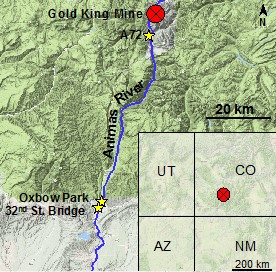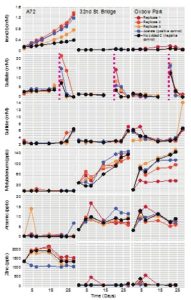Published in Environmental Science: Processes & Impacts, this study investigated the fate of heavy metals adsorbed onto riverbed sediments following the August 2015 Gold King Mine Spill in Colorado’s San Juan Mountains. It represents the first biogeochemical study of spill-impacted sediments from the Animas River and revealed mobilization of zinc, arsenic, and molybdenum species accompanying microbe-catalyzed dissolution of metal oxide sorbents.
Summary
Following the Gold King Mine waste spill, metal contaminants adsorbed onto riverbed sediments along the spill flow path. Differences in sediment mineralogy and adsorbed metals were strongly linked to sampling locations and proximity to the mine. Results suggest that anaerobic microbial metabolisms, stimulated by natural organic carbon pools, will play a significant role in mobilizing adsorbed metal pools following the onset of anoxia in buried riverbed sediments. The site-specific nature of metal release may be linked to different reductive metabolisms, with microbial iron reduction driving dissolution of grain coatings, and alkalinity increases during sulfate reduction offering another mechanism for metal desorption from fluvial sediments. Given the iron and sulfur-rich nature of the Colorado Basin, these complex processes represent a challenge for the tracking of mining-impacted biogeochemistry and associated water quality issues, and emphasize the need for monitoring efforts that account for the dynamic nature of fluvial systems, and their ability to moderate strong spatial and temporal gradients in redox status.
This study provides valuable insight into metal mobility, particularly in mining-impacted watersheds. These results highlight the importance of long-term river water quality monitoring as river sediments undergo sedimentation and burial processes, driving the onset of anoxic conditions which favor metal (re)mobilization.
Citation
Saup, C.M., K.H. Williams, L. Rodriguez-Freire, J. Manuel Cerrato, M.D. Johnston, M.J. Wilkins (2017). Anoxia stimulates microbially catalyzed metal release from Animas River sediments. Environmental Science: Processes & Impacts. doi:10.1039/C7EM00036G


